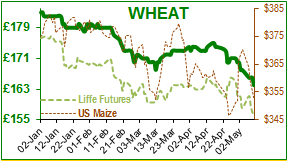The potential impact of the USDA report loomed over the trading week, making it quiet with low traded volumes although the UK wheat contracts continuing down this week.
The last valid old crop futures position of May closed the week at £154.70, whilst the November contract closed at £141.70, down £1.50 and 3.25 respectively. However, it should be noted that these values are unattractive to sellers so these lower values are difficult to buy. On Friday almost all trade on the Nov 19 contract was against actuals and the May 19 trade was almost non existent at 30 lots against actuals with no trades or tenders.
The USDA report did nothing to increase positivity or boost the volume of trading. Despite 2018/19 world end stocks remaining near 275 Mln T, the overall crop was raised by 12 Mln T. Increases were seen in the major exporting countries such as Russia, Ukraine, the EU, Canada and Argentina for a mix of improved weather conditions and increased planting area. The increased supplies give expectations of increased use, due to lower costs in food, feed and residual use. This report is the first to provide full estimates for the 2019/20 season its prediction of 19/20 wheat end stocks of 293 Mln T was above expected levels - a record level, which sent futures values to a 13 year low.
News that the US and China ended talks with yet another `no deal’, rather than reaching an agreement that many had hoped was near, caused Maize to fall 3%, and then wheat followed maize downward. It would currently take a major weather event or firm news, on one of the current world political events to help the grain trade to change the way they see commodity markets at present.
The USDA report gave estimates for the Soya bean end stock was below trade expectations for both the US and World stock. Despite this, the report increased the US 2018/19 soya bean carryout to 995 million bushels up by 100 million bushels mostly due to lower expectations for exports. This was then over shadowed by negative pressure from the news that president Trump had made the decision to increase tariffs on Chinese goods as a punishment for “reneging on the trade deal”. The news left soya bean prices at lows not seen in over 10 years (2008). World soya bean crops were raised by 2 Mln T in the USDA report and the crush was reduced by 2 Mln T, and export volumes down by 4 Mln T, half of which was attributed to lost Chinese trade. Add to this that the USDA called African Swine fever in China a `game changer’ and there was yet again little positive to report for the soya complex. China’s feed, and therefore its soya bean demand are expected to fall dramatically, after the Chinese Ministry of Agriculture and Rural affairs reported a 20% decrease in the pig herd size on top the expected reduction of levels used in feed due to the current trade disagreement with the US.
We have all heard the phrase `as dead as a dodo’. We might need to think of a new phrase for this special bird: the last surviving species of flightless bird in the Indian Ocean. It is a type of rail that had been thought to be extinct like the dodo, but it has been found `in hiding’, however it continued to evolve.
After being thought to be extinct for 136,000 years ago, the bird has `re-emerged’ through a process of “Iterative evolution”. The meaning of this is that the same structures evolve from the same common ancestor at different times. White-throated rails are about the same size as our chickens and originally come from Madagascar. They colonised many islands including Aldabra which has no predators, so the population on that island gradually lost the ability to fly. Unfortunately, the island disappeared under the sea, and so with it, disappeared the rails. 100,000 years ago the sea level changed again and the atoll once again evolved. Researchers compared the bones and found evidence that twice rails colonised the atoll from Madagascar and became flightless – independent of each other. This unique event was only possible because of Aldabra’s absence of terrestrial predators and competing mammals, and could only be proven because Aldabra has the oldest paleontological record of any oceanic island in the Indian Ocean region.
Perhaps now for the rail the phrase `a bird in the hand is worth two in the bush’ is more appropriate than ‘dead as a dodo’. In this case what it had really was best for the island…. twice!
Brought to you by Melanie Blake and Martin Humphrey.




















